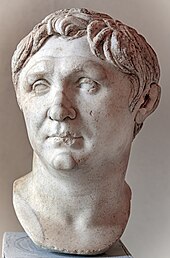Pompeian era

The Pompeian Era was a
epochal year of their calendars.[1] Some other nearby cities, such as Philadelphia, adopted the era even though they had never been under Hasmonean rule.[2]
When archaeologists find Pompeian dates on a city's coins and inscriptions, they use them as evidence of the city's membership in the Decapolis league. However, some cities that ancient writers listed in the Decapolis did not use Pompeian dates. In particular, Damascus continued to reckon dates using the Seleucid era.[3]
The region continued to use the Pompeian era during the
Muslim conquest of Syria in the 7th century CE. A church in Khilda, near Philadelphia (Amman), is inscribed with the Pompeian year 750, or 687 CE, several years after the Muslim conquest.[4]
Dates in the Pompeian Era
- 1 PE = 63 BCE
- 63 PE = 1 BCE
- 64 PE = 1 CE
- 699 PE = 636 CE (Battle of Yarmouk)
- 2089 PE = 2024 CE
See also
References
- ISBN 978-3-16-145241-3.
- ^ Kasher, 176.
- ISBN 978-0-391-04155-4.
- ^ Najjar, M. and Said, F. (1995). A New Umayyad Church at Khilda – Amman. Online: http://www.christusrex.org/www1/ofm/sbf/Books/LA44/44547MN.pdf Archived 2017-08-17 at the Wayback Machine. Accessed 26 August 2008.
